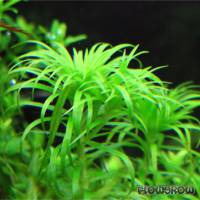



This highly finicky plant was found in very soft blackwater rivers and rivulets close to the mouth of the Amazon river. It was introduced to aquaristics under the name Tonina sp. 'Belém' by the Japanese company Rayon Vert. The name affix relates to the Brazilian city of Belém near which the plant was discovered.
Cavan Allen (of aquaticplantcentral.com) found out that this plant is not a Tonina but belongs to the genus Syngonanthus. Christel Kasselmann (2010) compared plant samples with herbar material from the Botanical Museum Berlin-Dahlem and found out that this plant is very problably Syngonanthus macrocaulon. Several authors consider this name a synonym of Syngonanthus anomalus.
Whereas Tonina fluviatilis, so far the only species in the genus Tonina, develops short-stalked flowers in the leaf axils along the stem, Syngonanthus species have long-stalked head-shaped flowers that appear in groups on the shoot tip, like the species in the genus Eriocaulon.
Syngonanthus macrocaulon is one of the most dificult plants to keep in an aquarium. It needs highly intensive light (around 1 watt per litre), the addition of CO2 and soft water (GH and KH not over 5). Like Tonina fluviatilis and Syngonanthus sp. 'Manaus', this plant also needs a slightly acidic substrate. Sufficient iron in the water is also very important to maintain its bright green colour.
The vertical growth of S. macrocaulon is moderately fast, as the plant rather applies its energy to the development of lateral shoots. When trimming, it is important to only cut the uppermost 4 cm of the stem to re-plant them in the substrate. Longer cuttings grow roots on the entire lower part of the stem, which looks rather ugly. Short cuttings grow better and look more beautiful in its further development.
It is said to live in symbiosis with mycorrhiza fungi, and thus it is recommended to add some material containing these fungi to the substrate near the plant to bring it to its full beauty. However, no concrete information is available on which fungi species are needed and if mycorrhiza fungi have indeed been found in the root system of Syngonanthus macrocaulon.
Due to its unique habit and growth form, Syngonanthus macrocaulon is a true eyecatcher in the aquarium. It is especially suitable as an accent plant in the middleground, and great in combination with grasslike plants like Sagittaria subulata. It is also a wonderful addition to so-called Tonina layouts dominated by plants of the Eriocaulaceae family like Tonina fluviatilis and all species of the genus Eriocaulon.
<a href="https://www.flowgrow.de/db/aquaticplants/syngonanthus-macrocaulon" target="_blank"><img alt="Syngonanthus macrocaulon" title="Syngonanthus macrocaulon" src="https://www.flowgrow.de/db/widget/aquaticplants/syngonanthus-macrocaulon" /></a>
[url=https://www.flowgrow.de/db/aquaticplants/syngonanthus-macrocaulon][img]https://www.flowgrow.de/db/widget/aquaticplants/syngonanthus-macrocaulon[/img][/url]
[widget=aquaticplants/syngonanthus-macrocaulon]Syngonanthus macrocaulon[/widget]